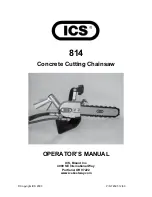
10
tree begins to fall remove the chainsaw
from the cut, stop the motor, put the
chainsaw down, then use the retreat
path planned. Be alert for overhead limbs
falling and watch your footing.
LIMBING
Limbing is removing the branches from
a fallen tree. When limbing, leave larger
lower limbs to support the log off the
ground. Remove the small limbs in one
cut. Branches under tension should be
cut from the bottom up to avoid binding
the chainsaw as shown in figure M. Trim
limbs from opposite side keeping tree stem
between you and saw. Never make cuts
with saw between your legs or straddle the
limb to be cut.
BUCKING
Bucking is cutting a felled tree or log into
lengths. How you should cut depends on
how the log is supported. Use a saw horse
(figure N) whenever possible.
• (Figure N) When using a saw horse
This is strongly recommended whenever
possible. Position the log in a stable
position. Always cut on the outside of the
saw horse arms.
Always start a cut with the chain running at
full speed.
• Place the bottom spike (22) of the
chainsaw behind the area of the initial cut
as shown in figure O.
• Turn the chainsaw on then rotate the
chain and bar down into the tree, using
the spike as a hinge.
• Once the chainsaw gets to a 45 degree
angle, level the chainsaw again and
repeat steps until you cut fully through.
• When the tree is supported along its
entire length, make a cut from the top
(overbuck), but avoid cutting the earth as
this will dull your saw chain quickly.
• (Figure P) When supported at one end
First, cut 1/3 the diameter from the
underside (underbuck). Then make the
finished cut by overbucking to meet the
first cut.
• (Figure Q) When supported at both ends
First, cut 1/3 down from the top
overbuck. Then make the finished cut by
underbucking the lower 2/3 to meet the
first cut.
• (Figure R) When on a slope
Always stand on the uphill side of the
log. When “cutting through”, to maintain
complete control release the cutting
pressure near the end of the cut without
M
N
2 (5cm)
INCHES
DIRECTION
OF FALL
2 (5cm)
INCHES
HINGE
NOTCH
FELLING BACK
CUT
L
Q
2nd CUT UNDERBUCK
(2/3 DIAMETER)
TO MEET 1st CUT
(TO AVOID PINCHING)
1st CUT OVERBUCK
(1/3 DIAMETER)
TO AVOID SPLINTERING
11
2
2nd CUT OVERBUCK
(2/3DIAMETER) TO MEET 1st
CUT (TO AVOID PINCHING)
1st CUT UNDERBUCK
(1/3 DIAMETER)
AVOID SPLINTERING
P
O
22
CUT FROM TOP
(OVERBUCK)
AVOID CUTTING EARTH











































